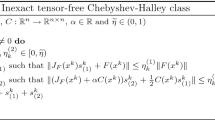Abstract
A number of methods that require only function evaluation to find a bracketed root are discussed. The Snyder, Pegasus, and Anderson-Björck schemes of Regula Falsi type converge superlinearly, but all use relatively slow secant steps. Two recent methods are faster because they exploit the rational interpolation step used by Anderson and Björck, and virtually eliminate secant steps.
Zusammenfassung
Mehrere Methoden zur Berechnung einer eingeklammerten Wurzel, die nur die Auswertung einer Funktion verlangen, werden diskutiert. Die Snyder-, Pegasus- und Anderson-Björck-Verfahren von der Regula-Falsi-Art konvergieren superlinear, aber alle benutzen relativ langsame Sekantenschritte. Zwei kürzlich entwickelte Methoden sind schneller, da sie den von Anderson und Björck benutzten rationalen Interpolationsschritt ausnutzen und fast ganz die Sekantenschrite eliminieren.
Similar content being viewed by others
Explore related subjects
Discover the latest articles, news and stories from top researchers in related subjects.References
Snyder, J. N.: Inverse interpolation, a real root off(x)=0. University of Illinois Digital Computer Laboratory, ILLIAC I Library Routine H1-71, 4 pages (1953).
Muller, D. E.: A method for solving algebraic equations using an automatic computer. Math. Comp.10, 208–215 (1956).
Jarratt, P., Nudds, D.: The use of rational functions in the iterative solution of equations on a digital computer. Comp. J.8, 62–65 (1965).
Dekker, T. J.: Finding a zero by means of successive linear interpolation. Dejon, B., Henrici, P. (eds.), Constructive aspects of the fundamental theorem of algebra. London: Wiley Interscience 1969.
Brent, R. P.: An algorithm with guaranteed convergence for finding a zero of a function. Comp. J.14, 422–425 (1971).
Dowell, M., Jarratt, P.: A modified Regula Falsi method for computing the root of an equation. BIT11, 168–174 (1971).
Dowell, M., Jarratt, P.: The “Pegasus” method for computing the root of an equation. BIT12, 503–508 (1972).
Anderson, N., Björck, Å: A new high order method of Regula Falsi type for computing a root of an equation. BIT13, 253–264 (1973).
King, R. F.: An improved Pegasus method for root finding. BIT13, 423–427 (1973).
Bus, J. C. P., Dekker, T. J.: Two efficient algorithms with guaranteed convergence for finding a zero of a function. Mathematical Centre Report NW 13/74, Amsterdam, Sept. 1974, 27 pages.
Author information
Authors and Affiliations
Additional information
Work performed under the auspices of the U.S. Energy Research and Development Administration.
Rights and permissions
About this article
Cite this article
King, R.F. Methods without secant steps for finding a bracketed root. Computing 17, 49–57 (1976). https://doi.org/10.1007/BF02252259
Received:
Revised:
Issue Date:
DOI: https://doi.org/10.1007/BF02252259




